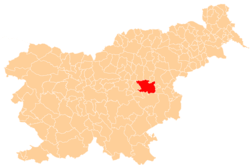Laško
| Laško | |
|---|---|
 | |
 Laško Location in Slovenia | |
| Coordinates: 46°9′22.69″N 15°14′19.02″E / 46.1563028°N 15.2386167°ECoordinates: 46°9′22.69″N 15°14′19.02″E / 46.1563028°N 15.2386167°E | |
| Country |
|
| Traditional region | Styria |
| Statistical region | Savinja |
| Municipality | Laško |
| Area | |
| • Total | 3.30 km2 (1.27 sq mi) |
| Elevation | 259.9 m (852.7 ft) |
| Population (2012) | |
| • Total | 3,416 |
| Climate | Cfb |
| [1] | |
Laško (pronounced [ˈlaːʃkɔ]; German: Tüffer) is a spa town in eastern Slovenia. It is the seat of the Municipality of Laško. Traditionally the area was part of the Styria region. The municipality is now included in the Savinja Statistical Region. The town is located at the foothills of Hum Hill on the Savinja River. It was first mentioned in written documents dating to 1227 and was granted town privileges in 1927.[2] It is known to have been settled since the Iron Age and Roman archaeological finds are common in the area, though the precise location of the Roman settlement is not known.[3] Today the town is best known for its annual Festival of Beer & Flowers (Pivo - Cvetje) and the local Laško Brewery, the largest brewery in the country.[4] In 2010, Laško was heavily affected by flooding.
The town's coat of arms depicts three white fleurs-de-lis on a blue field.
The local castle, known as Tabor Castle, dates to the 12th century, although it was first mentioned in written sources dating to 1265. It was burned down during Ottoman Raids in the late 15th century and was extended in the 16th century.[5]
The parish church in the settlement is dedicated to Saint Martin and belongs to the Roman Catholic Diocese of Celje. It is a Romanesque building dating to the 13th century with various later additions and adaptations.[6]
Spa
The healing properties of the local waters have been known since antiquity. Laško developed as a health resort towards the end of the 19th century.[7]
In 1818 a report appeared in a Graz newspaper about the Laško springs. The water temperature was measured at 35 °C (95 °F) and the establishment of a health spa was announced. An engineer named Rödel began to work systematically on the springs during the construction of the railway line. Work progressed from September 1852, when he purchased the land, until May 1854, when he ceremoniously opened the spa. The three springs were each given a name: the Emperor's Spring, Franz's Spring, and Joseph's Spring. The spa was given the name Kaiser Franz Josef Bad, after Emperor Franz Joseph I of Austria. Along with a building with a pool, Rödel also rearranged the nearby mill and built a luxurious mansion. In 1857 the spa was purchased by a Viennese professor and cosmopolitan named Stein, who invited the cream of Viennese society to the health spa. For this purpose he built an extension onto the spa building with a dance hall and planted a park. He also took care of his guests' social life. Stein was later forced to sell the spa. The spa's reputation returned under a later owner named Gunkel, who radically renovated it and in 1882 built his own hydroelectric power plant, the first on Slovene soil, which lit up most of the buildings and the whole park. In cooperation with the brewery, they began to brew thermal beer. During World War I the spa played the role of a military hospital. The property was left in disrepair after the war, but was partly renovated in 1923. Later the spa passed into the hands of the Pensions Institute (Pokojninski zavod) and the Central Office for Workers' Insurance (Osrednji urad za zavarovanje delavcev).
In October 1953, the spa was registered as a medical rehabilitation centre. Further development mainly followed the needs of the healthcare service and to a large degree it was the fruit of cooperation with the orthopedic (later neurological, traumatology, and neurosurgical) clinics in Ljubljana, regional hospitals, and health centres across Slovenia.
The Laško Thermal Spa Resort is becoming one of the most important health spas and tourist centres in Slovenia.
Mass graves
Laško is the site of two known mass graves from the period immediately after the Second World War. The Funeral Chapel Mass Grave (Slovene: Grobišče pri pokopališki vežici) is located west of the Laško Brewery, under the funeral chapel outside the east wall of the town cemetery. The grave contains the remains of Croatian prisoners of war that were murdered after the war.[8] The Cemetery Mass Grave (Grobišče na pokopališču) is located in an unmarked part of the town cemetery. The grave contains the remains of Croatian victims that were discovered during excavations and reburied.[9]
References
- ↑ Statistical Office of the Republic of Slovenia
- ↑ Laško municipal site
- ↑ Slovenian Ministry of Culture register of national heritage reference number ešd 12264
- ↑ Laško Brewery site
- ↑ Slovenian Ministry of Culture register of national heritage reference number ešd 14849
- ↑ Slovenian Ministry of Culture register of national heritage reference number ešd 309
- ↑ Jeannie Bastian. The Town of Beer & Flowers. Accessed November 15, 2006.
- ↑ Funeral Chapel Mass Grave on Geopedia (Slovene)
- ↑ Cemetery Mass Grave on Geopedia (Slovene)
External links
| Wikimedia Commons has media related to Laško. |
- Laško on Geopedia
- Laško municipal website (Slovene)
- Laško – the Confluence of Good
- Festival of Beer and Flowers
- Festival background
